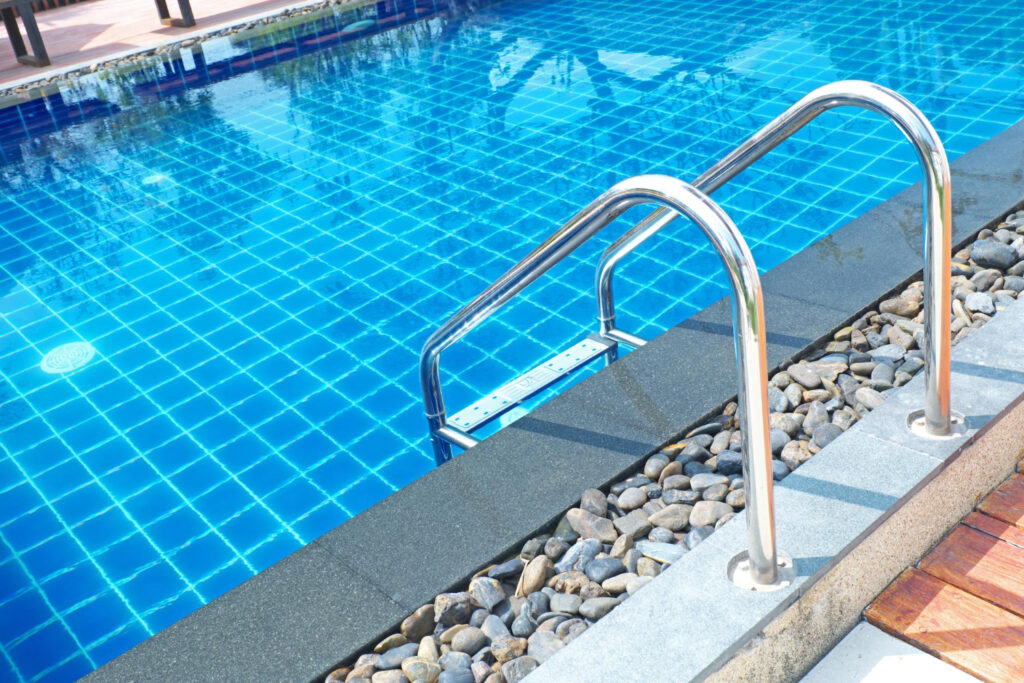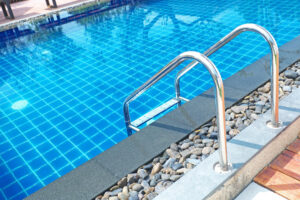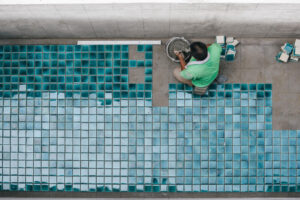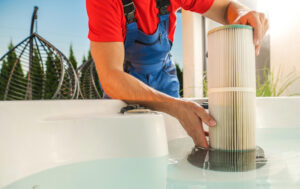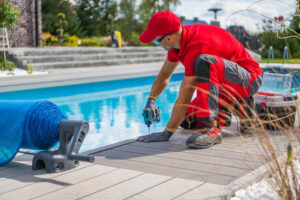Many pool owners wonder if they should switch from traditional chlorine systems to saltwater pools. Saltwater pool installation offers softer water that’s gentler on skin and eyes, but they come with higher upfront costs and different maintenance needs. The choice depends on your budget, swimming habits, and long-term goals for your backyard.
In this article, we’ll walk you through how saltwater systems actually work and what makes them different from regular chlorine pools. You’ll learn about the real costs involved, from initial setup to ongoing maintenance, so you can make a smart decision for your family.
Let’s break down the key points you should consider:
- Is a salt water pool system worth it for your lifestyle?
- How saltwater pool installation works with precast pools
- Understanding salt water pool installation cost
- Ongoing salt water pool maintenance essentials
Whether you’re building a new pool or thinking about converting your current one, this guide covers everything you need to know.
What makes saltwater pools different from traditional systems
Saltwater pools use a different approach to water treatment than traditional chlorine systems. The main difference is how each system creates sanitization and what this means for pool owners.
Salt water pool vs chlorine: what to know before choosing
Traditional chlorine pools require us to add liquid or granular chlorine directly to the water. We must test the water regularly and add chemicals to keep the chlorine levels balanced.
Saltwater pools still use chlorine for sanitization. The key difference is how the chlorine gets into the water. Instead of adding chlorine directly, we add pool-grade salt to the water.
Key Differences:
| Feature | Traditional Chlorine | Saltwater Pool |
| Chlorine source | Added directly | Generated from salt |
| Water feel | Can feel harsh | Softer, smoother |
| Maintenance | Frequent chemical additions | Less chemical handling |
| Initial cost | Lower setup cost | Higher equipment cost |
The water in saltwater pools feels softer and smoother on skin and hair. This happens because the salt content is much lower than ocean water. Most saltwater pools contain about 3,000 parts per million of salt compared to 35,000 ppm in ocean water.
How salt water pools generate their own sanitization
Saltwater pools use a device called a chlorine generator or salt cell. This system converts salt into chlorine through a process called electrolysis.
The generator has metal plates that create an electrical current. When salt water passes through these plates, the salt breaks down into sodium and chlorine. The chlorine then sanitizes the pool water.
The Process:
- We add pool-grade salt to the water
- Water flows through the salt cell
- Electrical current splits salt molecules
- Chlorine is released into the pool
- Chlorine eventually converts back to salt
This creates a continuous cycle. The same salt gets reused over and over. We only need to add more salt when water is lost through splashing, backwashing, or drainage.
The generator runs automatically based on a timer or pool system controls. This means less daily maintenance compared to adding chlorine manually.
Why more homeowners are shifting toward salt-based systems
More families are choosing saltwater pools because they offer several benefits over traditional systems. The main reasons include comfort, convenience, and long-term costs.
Comfort benefits draw many homeowners to salt-based systems. The water feels gentler on skin and eyes. Swimmers often report less irritation and fewer strong chemical smells around the pool area.
Maintenance advantages make saltwater pools appealing to busy families. We handle fewer chemicals on a regular basis. The system produces its own sanitization automatically.
Long-term cost savings can offset the higher initial investment. While the generator costs more upfront, we buy less chemicals over time. Salt costs much less than regular chlorine products.
However, saltwater systems do require specialized knowledge for repairs. When the generator needs service, we need technicians who understand salt cell technology. This can make some repairs more expensive than traditional pool equipment fixes.
Is a salt water pool system worth it for your lifestyle?
Saltwater pools offer distinct advantages like gentler water and reduced chemical handling, but they come with higher upfront costs and specific maintenance needs. Your decision depends on how much you value comfort versus budget considerations and how often you plan to use your pool.
Lower chemical use and softer water feel
Saltwater pool systems create chlorine through electrolysis, which means we don’t need to store or handle liquid chlorine regularly. The salt chlorine generator converts salt into chlorine automatically, maintaining steady sanitization levels.
The water feel is noticeably different from traditional pools. Saltwater pools typically contain 3,000 to 4,000 parts per million of salt, creating softer water that’s gentler on skin and eyes.
We experience less chlorine smell because the system produces chlorine in smaller, more consistent amounts. This reduces the harsh chemical odors that come from adding large doses of chlorine.
Chemical use benefits include:
- No need to buy and store liquid chlorine
- Reduced skin and eye irritation
- Less frequent water testing required
- Automatic chlorine production
The salt doesn’t need frequent replacement either. After the initial salination, we typically only add salt when water is lost through splashing or backwashing.
What is the downside of a saltwater pool?
The saltwater pool system requires a significant upfront investment. Salt chlorine generators cost $1,000 to $2,500, plus installation fees.
Salt is corrosive to certain materials. We need to check that our pool equipment, deck materials, and nearby metal fixtures can handle salt exposure. Some heaters, ladders, and light fixtures may corrode faster.
The generator cell needs replacement every 3-5 years, costing $200 to $700. This is an ongoing expense we must budget for.
Maintenance challenges include:
- More complex troubleshooting when problems occur
- Higher electricity costs to run the generator
- Need for specialized repair knowledge
- Potential damage to pool equipment
Salt levels must stay within specific ranges. Too little salt means poor chlorine production, while too much can damage the generator and create uncomfortable swimming conditions.
Matching expectations with pool usage and budget
Frequent swimmers benefit most from saltwater systems. If we use our pool regularly, the comfortable water feel and reduced chemical exposure justify the higher costs.
Our budget needs to account for both initial and ongoing expenses. The system pays off over time through reduced chemical purchases, but the upfront cost is substantial.
For homeowners seeking eco-friendly heating options, integrating a solar pool heater with your saltwater system is smart—the DOE reports solar pool equipment costs $2,500–$4,000 and operates at very low annual cost.
Consider saltwater if we:
- Swim multiple times per week
- Have sensitive skin or allergies
- Want easier daily maintenance
- Can afford the initial investment
Traditional chlorine pools work better for occasional use or tight budgets. The lower setup costs and simpler maintenance make more sense for weekend-only swimmers.
Pool size matters too. Larger pools benefit more from automatic chlorine generation, while smaller pools may not justify the system cost.
How saltwater pool installation works with precast pools
Precast pools work well with saltwater systems and require specific steps during delivery and setup. The installation process involves checking compatibility and planning the integration during the initial pool placement.
Salt water precast pool compatibility
Most precast pools are fully compatible with saltwater systems. The concrete construction handles salt water better than some other pool materials.
Key compatibility factors:
- Concrete walls resist salt corrosion
- Standard plumbing works with salt systems
- Electrical systems need proper grounding
- Metal fixtures may need upgrades
We recommend checking the pool manufacturer’s specifications before installation. Some precast pools come pre-wired for saltwater systems.
The salt generator typically mounts near the equipment pad. This location keeps the system accessible for maintenance while staying close to the pool plumbing.
Equipment requirements:
- Salt cell generator unit
- Control panel
- Proper electrical connection (220V)
- Bypass valve system
Integrating a salt system into your delivery and setup
The best time to add a saltwater system is during the initial pool installation. This timing allows for proper plumbing connections and electrical work.
Installation sequence:
- Set precast pool in place
- Connect main plumbing lines
- Install salt system bypass
- Mount generator and control panel
- Complete electrical connections
We coordinate with electrical contractors during this phase. The salt system needs dedicated electrical service that meets local codes.
Plumbing integration happens after the pool is level and stable. The salt cell connects to the return line through a bypass valve system.
This setup allows water to flow through the generator or around it for maintenance. The bypass valve gives you control over the salt system operation.
How Little Dipper streamlines saltwater system installs
Little Dipper simplifies the saltwater installation process through careful planning and coordination. We handle the technical details so you get a complete system.
Our installation process:
- Pre-delivery site assessment
- Coordinated electrical planning
- Professional plumbing integration
- System testing and startup
We work with certified electricians who understand saltwater system requirements. This partnership ensures proper grounding and electrical safety.
The installation team brings all necessary components on delivery day. We test the complete system before leaving your property.
What we provide:
- Salt cell generator
- Digital control panel
- Bypass valve assembly
- Initial salt addition
- System training
We also provide startup instructions and maintenance schedules. This support helps you get the most from your new saltwater system.
Understanding salt water pool installation cost
Salt water pool installation costs range from $25,000 to $57,000 for new pools, while converting an existing pool typically costs $600 to $2,200. System pricing depends on pool size, materials, and location factors.
How much does it cost to install a saltwater pool?
Installing a new saltwater pool requires a significant upfront investment. The national average cost sits around $32,000 for most installations.
Cost ranges by pool size:
- Small pools (under 20,000 gallons): $10,000 – $20,000
- Average inground pools: $29,000 – $57,000
- Large custom installations: Up to $50,000+
Pool size creates the biggest price difference. Smaller pools need less equipment and fewer materials.
The installation cost includes excavation, plumbing, electrical work, and the salt water system itself. We see prices vary widely based on local labor costs and permit requirements.
Monthly maintenance costs run $70 to $100 after installation. This covers salt, testing supplies, and occasional cell replacement.
Factors influencing system pricing and setup
Several key factors affect your total installation cost beyond just pool size.
Material choices impact pricing significantly:
- Concrete pools: Most expensive but longest lasting
- Vinyl liner pools: Mid-range pricing option
- Fiberglass pools: Quick installation, moderate cost
Location factors also drive costs up or down. Areas with rocky soil need more excavation work. Cold climates require deeper digging below frost lines.
Pool shape and features add complexity. Simple rectangular pools cost less than curved designs with steps and benches.
The salt water system quality affects long-term costs. Higher-end systems last longer but cost more upfront. We recommend investing in reliable equipment to avoid frequent repairs.
Local permits and inspections add $500 to $2,000 in most areas. Some regions have stricter requirements that increase costs.
How much is it to convert to a saltwater pool?
Converting your existing chlorine pool to saltwater costs much less than new installation. This option saves thousands compared to building from scratch.
Conversion costs by pool type:
- Above-ground pools: $600 – $1,100
- Inground pools: $1,100 – $2,200
The conversion process involves installing a salt chlorine generator and adding salt to your existing water. Most pools need minimal plumbing changes.
What’s included in conversion:
- Salt water generator unit
- Professional installation
- Initial salt supply
- System testing and balancing
We find most conversions take 1-2 days to complete. Your existing pump and filter system usually work fine with the new salt system.
Additional costs might include water testing ($50-100) and minor electrical work if your system needs upgrades. Some older pools need new control panels.
Ongoing salt water pool maintenance essentials
Salt water pools require consistent maintenance to keep your system running smoothly and water crystal clear. The salt chlorinator system reduces some daily tasks while creating new responsibilities for equipment care and water balance.
What you’ll need to maintain clarity and balance
Your salt water pool needs regular testing and chemical adjustments to stay balanced. We recommend testing your water 2-3 times per week during swimming season.
Essential maintenance supplies include:
- Salt water test strips or digital test kit
- pH increaser and decreaser
- Alkalinity increaser
- Calcium hardness increaser
- Pool salt (sodium chloride)
- Stabilizer (cyanuric acid)
The ideal water chemistry ranges are:
- Salt level: 2,700-3,400 ppm
- pH: 7.2-7.6
- Total alkalinity: 80-120 ppm
- Calcium hardness: 150-300 ppm
You’ll need to clean your pool filter every 4-6 weeks. The skimmer baskets should be emptied weekly during heavy use.
Salt cells require monthly inspection for calcium buildup. Clean them with a mild acid solution when white deposits appear on the plates.
How salt systems reduce routine upkeep
Salt chlorinator systems create chlorine automatically from dissolved salt. This eliminates the need to add liquid chlorine or tablets regularly.
The system produces a steady, consistent chlorine level. You won’t experience the highs and lows that come with manual chlorine additions.
Reduced maintenance tasks include:
- No weekly chlorine shocking (except during heavy use)
- Less frequent chemical store trips
- Fewer skin and eye irritations from chlorine handling
- More stable sanitizer levels
The salt cell operates on a timer system. You can adjust chlorine production based on bather load and weather conditions.
Salt water is gentler on pool equipment and surfaces. This means less wear on ladders, lights, and pool liners over time.
Conclusion
Saltwater pools offer a compelling alternative to traditional chlorine systems. The decision comes down to your priorities and budget.
We’ve seen that saltwater pools provide softer water and reduced chemical handling. They’re gentler on skin and eyes. The ongoing maintenance can be simpler once you understand the system.
However, the upfront costs are higher. Installation requires specialized equipment and expertise. Repairs need technicians trained in salt systems.
Neither option is universally better. Chlorine pools work well for many homeowners. Saltwater pools suit others perfectly.
We recommend talking to local pool contractors. Get quotes for both systems. Ask about maintenance requirements in your area.
Make your choice based on facts, not trends. Consider your family’s needs, your budget, and your comfort with technology.
The right pool system is the one that fits your lifestyle and financial situation. Both saltwater and chlorine pools can provide years of enjoyment when properly maintained.

